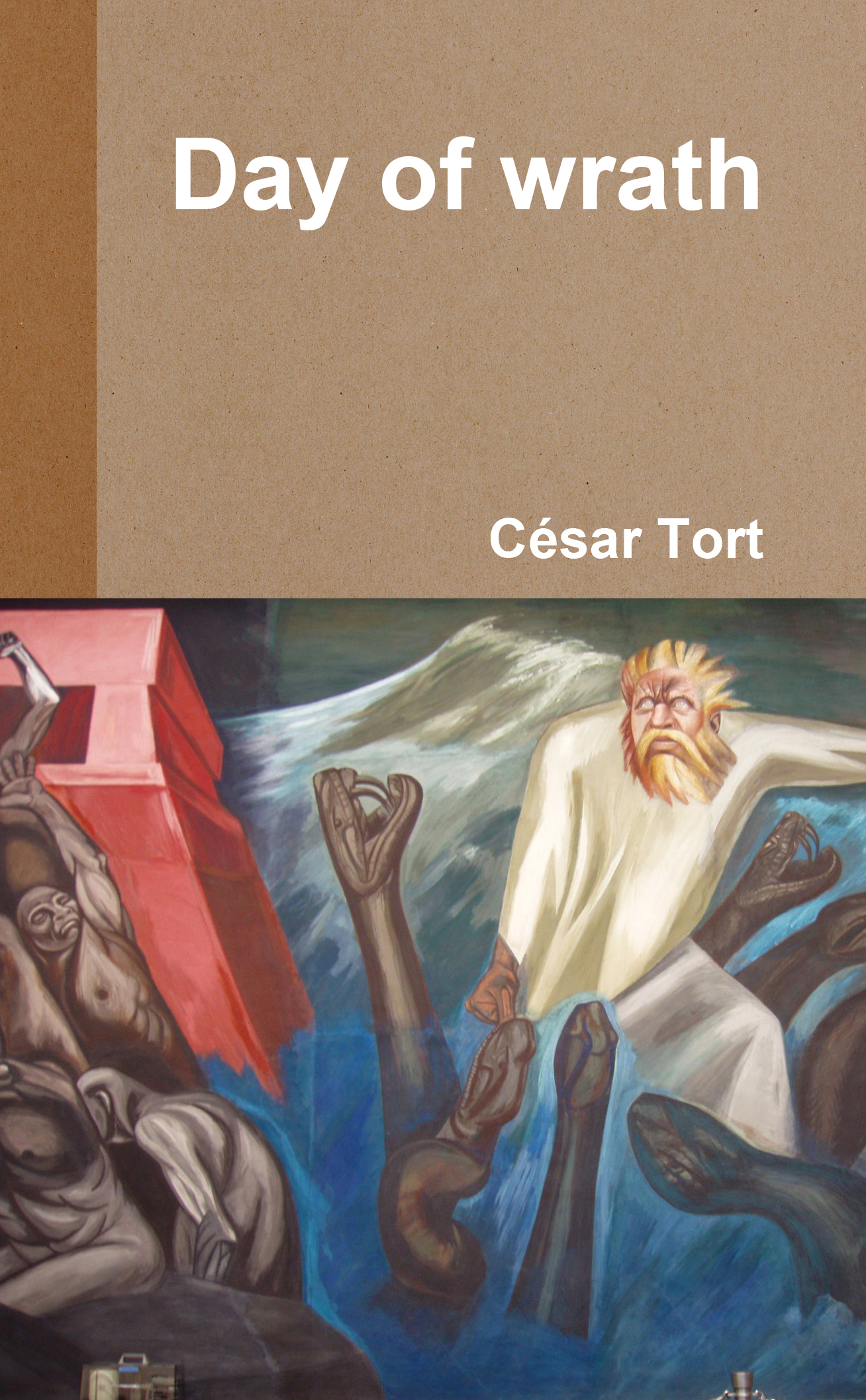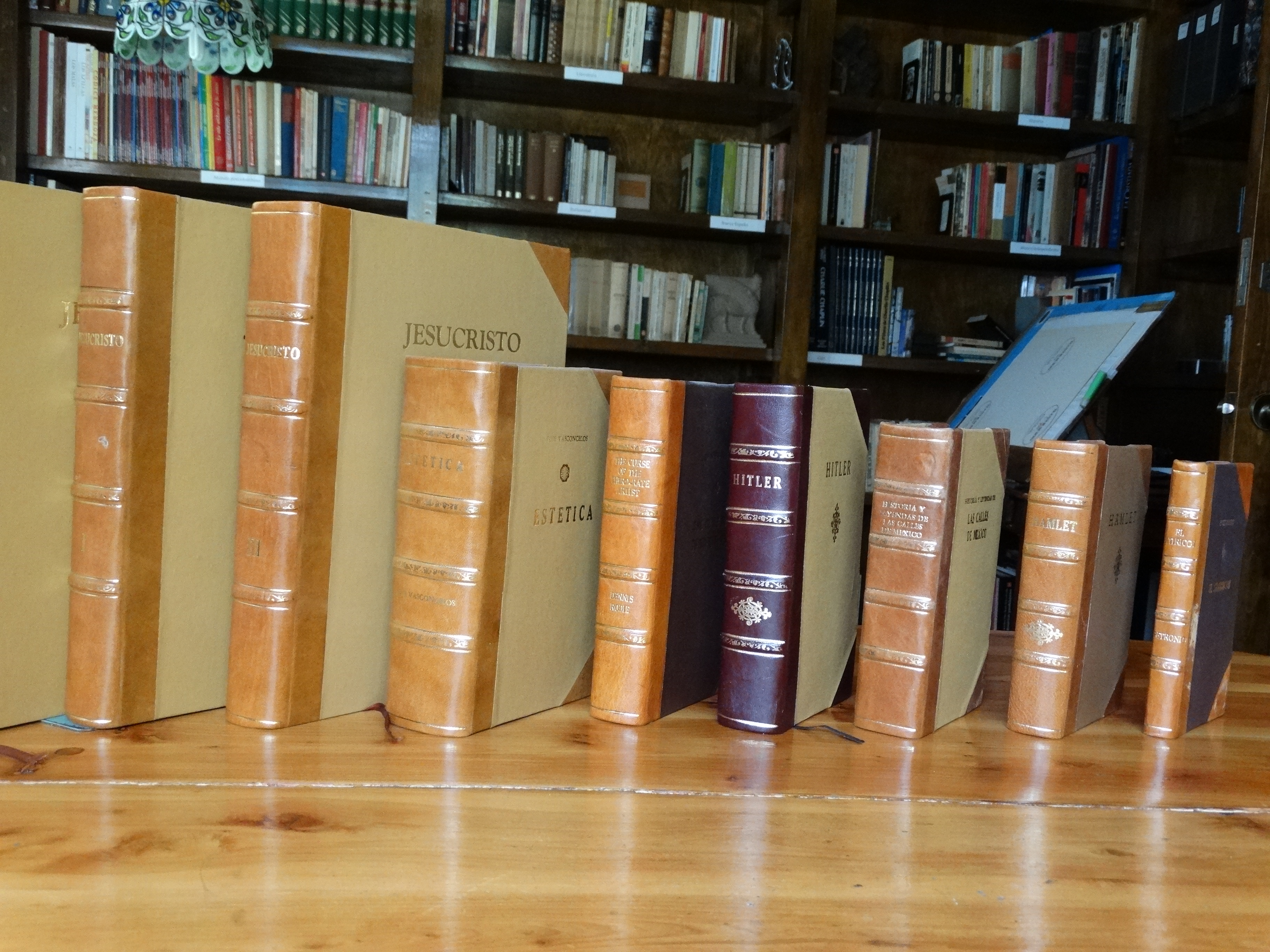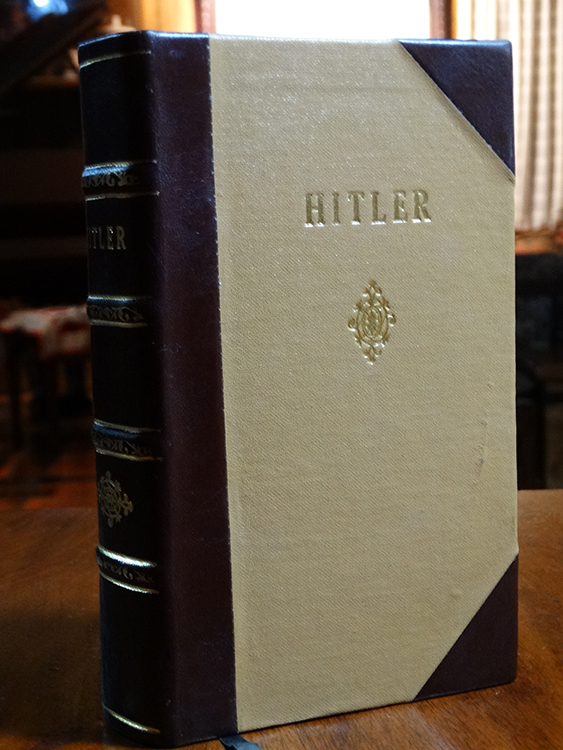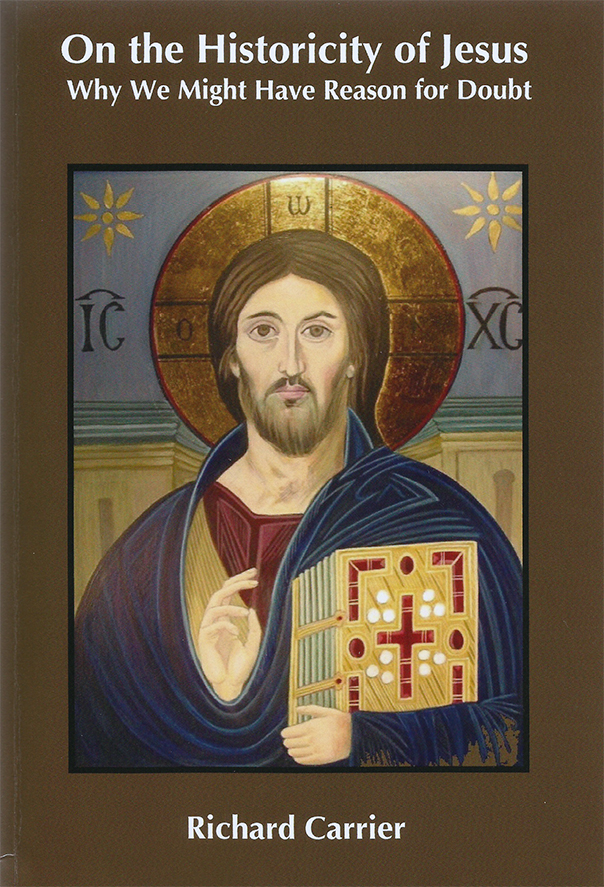These days I’m still busy reviewing the syntax of From Jesus to Hitler before I send the manuscript to the printers.
Category: Daybreak Publishing
I recently flipped through the copy of the 2014 edition of The Fair Race that I own and was surprised that, since that year, I have eliminated no less than… fifty essays!
Many of the removed essays were brief, as the 2014 edition has 432 letter-size pages. Unlike that clumsy size for the first edition, the most recent ones of The Fair Race are of regular size for printed books. The 2019 edition for instance (pic above) contains 580 pages.
In the prologue of this last edition I mention the impact that, since the end of last year, Richard Carrier’s book has caused in my vision about the historicity of Jesus. For the same reason, I removed a footnote I had added, in the 2018 edition, within Evropa Soberana’s essay, ‘Rome vs. Judea; Judea vs. Rome’. On that note, now obsolete, you see that the previous year I still believed that there could have existed an ordinary Jew who became deified by the primitive Christian community. Now I believe that the whole story about Jesus was an invention of Mark the Evangelist. To understand the whys see the bold letters in my first essay-review articleof Carrier’s book.
Almost ten years ago I discovered the literature of white nationalism, when I lived in the island Gran Canaria, Spain. As can be seen in the metamorphosis recorded in the several editions of The Fair Race, with those 50 eliminated essays (as well as adding other essays), I constantly sharpen my vision of the world. Given my perfectionism, and that I am interested that new visitors of this site open the updated PDF of Soberana’s essay, I have deleted the old PDF of ‘Rome vs. Judea; Judea vs. Rome’ that contained that obsolete footnote. Instead, in the sticky post I have linked the version of Soberana’s essay that now appears in the print edition of 2019, the version without that footnote (see the first comment below).
Such perfectionism has a setback, of course. As I had been linking the old PDF in several entries and even in comments in other forums, when they click on my old links no document will show up. However, the most updated version of Soberana’s essay will always be linked in the sticky post of this site.
If there is a book that now contains the crème de la crèmeof the literature in favour of the 14 words, it is the latest edition of The Fair Race.
Finally, the abridged translation of Karlheinz Deschner’s book on the history of Christianity is available in printed form (here).
This January, in a discussion thread at The Occidental Observer, Karl Nemmersdorf, the Christian author of the featured article, told me ‘Um… no, I don’t follow your blog. Please let me know, however, if you supersede St. Paul, St. Augustine, St. Aquinas…’
In other words, these guys are so giants that I could not possibly mess with their divine wisdom. But however erudite Nemmersdorf may be in traditional Catholic literature, he is ignorant about the real story of his religion. His ignorance is explainable because only until very recently did someone turn his life into the encyclopaedic mission of uncovering the criminal history of Christianity. Apparently, white people had been unable to read an encyclopaedic work about real Church history for the simple reason that it didn’t exist before Deschner.
The fact is that the Big Guys mentioned by Nemmersdorf, Paul (recently discussed in this site in several posts), Augustine and Aquinas, were evil men. And evil men were also the church doctors in Augustine’s times, Athanasius and Ambrose, as demonstrated by Deschner.
Remember that I offered my opinion on a recent article by Andrew Joyce about Jewish psy-ops: they have infiltrated our educational system in order to brainwash generations of white children. Well, although Ambrose probably was not Jewish he was not white either, as can be seen in this ancient mosaic. In a passage from this first translated volume, Deschner talks about the psy-ops that this non-white doctor used to brainwash the Roman princes:
Bishop Ambrose saw the sovereigns daily. Since when Valentinian II was proclaimed Augustus (375) he was barely five years old, his tutor and half-brother Gratian had just turned sixteen and the Spanish Theodosius was at least a very determined Catholic, the illustrious disciple of Jesus could handle perfectly their majesties. Valentinian I died a few years after Ambrose’s inauguration. His son Gratian (375-383), of just sixteen years of age, succeeded him on the throne.
The emperor, blond, beautiful and athletic had no interest in politics. ‘I have never learned what it means to govern and be governed’ (Eunapius). He was a passionate runner, javelin thrower, fighter, rider, but what he liked most was killing animals. Neglecting the affairs of state, every day he killed countless of them, with an almost ‘supernatural’ ability, even lions, with a single arrow.
Note how this is eerily similar to contemporary Aryan frivolity in extreme sports—at the same time that the Jews plot how to exterminate them! (which is why we speak about an ‘Aryan question’ beside the ‘Jewish question’).
In any case, he also prayed every day and was ‘pious and clean of hearing’, as Ambrose affirmed: ‘His virtues would have been complete had he also learned the art of politics’. However, this art was practiced by Ambrose for him. Not only did he personally guide the young sovereign, effectively since 378: he also influenced his government measures. At that time the sovereign had promulgated, by an edict, precisely tolerance towards all confessions, except a few extremist sects. However, Ambrose, who four years before was still unbaptized, hastened to write a statement, De fide ad Gratianum Augustum (Faith for Gratian), which he quickly understood.
As soon as Gratian himself arrived at the end of July 379 in Milan, neutral as he was from the point of view of religious policy, he annulled on August 3, after an interview with Ambrose, the edict of tolerance promulgated the year before.
The Greco-Roman religion, reviled as ‘pagan’ by Christian Newspeak, was a religion originated by pure whites (see the articles of Evropa Soberana in The Fair Race). Eventually, the white religion was prohibited and the Jewish god imposed on all Roman citizens. A few pages later, Deschner tells us:
The young Gratian at first had given a good treatment to the ‘pagans’, but he learned from his spiritual mentor ‘to feel the Christian Empire as an obligation to repress the old religion of the state’ (Caspar).
Other early Christian writers were most likely ethnic Jews, as can be guessed when pondering on how they avenged the destruction of the Temple in Jerusalem a few centuries earlier:
Lactantius [an early Christian author who became an advisor to the first Christian Roman emperor, Constantine I] is the one who then states that the sovereigns of the gentiles [emphasis added] were ‘criminals before God’, and he celebrates that they have been ‘exterminated from the root with all their type’. ‘Now those who pretended to defy God are laid prostrate on the ground; those who knocked down the Temple were slow to fall, but they fell much lower and had the end they deserved’.
Judeo-Christianity conquered the Roman Empire because the empire had become the melting-pot for non-white peoples, Jews included, who took advantage of the Roman upward mobility after the old religion became obsolete. This site, The West’s Darkest Hour is based on a passage from William Pierce’s Who We Are: that the ancient Greeks and Romans should have gotten rid of non-whites instead of using them as slaves or second-class citizens. If pre-Christian emperors had taken heed of a Cassandra prophecy, what Deschner says would not have occurred:
Constantine dedicated ten years to rearmament and propaganda in favour of Christianity as in the East; for example in Asia Minor, half of the population was already Christian in some areas [i.e., non-white]. After those ten years he rose again in search of the ‘final solution’.
That the earliest Christians were not white but fully Semitic is apparent in the footnotes below these maps provided by Evropa Soberana. We can assume that by the time of Constantine most Christians were also non-white, as Christians preached slave morality, blessed are the poor, etc. But I would like to continue to respond to the erudite Christian authors and commenters at The Occidental Observer. Not only St. Ambrose was non-white but St. Augustine was not white either (scholars generally agree that Augustine’s parents were Berbers), and probably the other great Church doctor of the time, St. Athanasius, was another non-white. Deschner wrote:
Probably like Paul and like Gregory VII, Athanasius was short and weak; Julian calls him homunculus. However, like Paul and Gregory, each one of them was a genius of hatred.
This suggest that Athanasius did not belong to the handsome Latin race (‘Aryan race’ the Nazis would say) to which Emperor Julian belonged. Like Nemmersdorf , Lew Wallace, author of the huge bestseller Ben-Hur: A Tale of the Christ, did not admire Julian but the Christian emperors. What white nationalists ignore is that, without millions of useful idiots like this pair, the Jews would never have taken over the United States. These are the final words of Ben-Hur:
If any of my readers, visiting Rome, will make the short journey to the Catacomb of San Calixto, which is more ancient than that of San Sebastiano, he will see what became of the fortune of Ben-Hur, and give him thanks. Out of that vast tomb Christianity issued to supersede the Caesars.
The reading of Deschner’s books, and I mean not only this first translated volume but the next ones, will convince the honest reader that—contra Wallace—compared to the monstrous Christian emperors, the pagan Caesars were almost saints. If life allows, we will reach the pages where Deschner debunks the last doctor of the church mentioned by Nemmersdorf, Thomas Aquinas, but that is still too many books ahead.
For the moment, this is the Contents page of our first translation of:
Christianity’s Criminal History
Editor’s preface
Introduction
The Early Period: from Old Testament origins to the death of Saint Augustine
Forgeries in the Old Testament
The bibles and some peculiarities of the Christian Bible
The five books of Moses, which Moses did not write
David and Solomon
Joshua and Isaiah
Ezekiel and Daniel
The Jewish apocalyptic
Portrayals of the biblical female world
Opposition to the Old Testament
Forgeries in diaspora Judaism
Forgeries in the New Testament
The error of Jesus
The ‘Holy Scriptures’ are piled up
God as the author?
Christians forged more consciously than Jews
Neither the Gospel of Matthew, nor the Gospel of John, nor John’s Book of Revelation come from the apostles to whom the Church attributes them
Forged ‘epistles of Paul’
The Second Epistle to the Thessalonians
Colossians, Ephesians and Hebrews
Forged epistles of Peter
Forged John and others
Interpolations in the New Testament
The invention of Popes
Neither Jesus instituted the papacy nor Peter was bishop of Rome
There is no evidence of Peter’s stay and death in Rome
The story of the discovery of Peter’s tomb
The list of fabricated Roman bishops
Background in the Old Testament
Moses and the Book of Judges
The ravages of David and the modern translators
The sacred warmongering of the Maccabees
The Jewish War (66-70)
Bar Kokhba and the ‘Last War of God’ (131-136)
The Jewish religion, tolerated by the pagan state
Early Christianity
Interpretatio Christiana
‘Orthodoxy’ and ‘heresy’
First ‘heretics’ in the New Testament
Thirteen good Christians
Saint Jerome and Origen
The persecution of the Christians
Anti-Hellene hatred in the New Testament
The defamation of the Greco-Roman religion
Celsus and Porphyry
The persecution of the Christians
Most of the written statements about the martyrs are false, but all of them were considered as totally valid historical documents
The Roman emperors viewed retrospectively
Saint Constantine: The First Christian Emperor
War against Maxentius
War against Maximinus
War against Licinius
The Catholic clergy, increasingly favoured
Constantine as saviour, deliverer, and vicar of God
No more a pacifist Church
Christian family life and savage criminal practices
Constantine against Jews and ‘heretics’
Constantine against the Greco-Roman culture
Interim report
Persia, Armenia and Christianity
Constantine’s successors
The first Christian dynasty founded on family extermination
First wars among devout Christians
Constantius and his Christian-style government
A father of the Church who preaches looting and killing
First assaults on the temples
Julian
Hecatombs under the pious Gallus
Emperor Julian
Christian tall stories
After Julian
Rivers of blood under the Catholic Valentinian
Trembling and gnashing of teeth under the Arian Valens
Athanasius, Doctor of the Church
The complicated nature of God
It was not fought for faith but for power
The Council of Nicaea
Character and tactics of a Father of the Church
The death of Arius
The ‘battlefield’ of Alexandria
Antioch and Constantinople
Shelter with a twenty-year-old beauty
Ambrose, doctor of the Church
Non-white Ambrose drives the annihilation of the Goths
Emperor Theodosius ‘the Great’
Against the Hellenist religion
The Father of the Church Augustine
‘Genius in all fields of Christian doctrine’
Augustine’s campaign against the Donatists
The overthrow of Pelagius
Augustine attacks Greco-Roman culture
Augustine sanctions the ‘holy war’
The 2018 (revised) edition is available
through Amazon Books: here.
 Preface to the 2018 edition
Preface to the 2018 edition
Day of Wrath is the companion of The Fair Race’s Darkest Hour, where I collect the essays of other authors for readers who want to save the white race from extinction.
Under the covers of this book I include six Spanish-English translations from chapters of my volumes Hojas Susurrantes and ¿Me Ayudarás? [see the bottom of this page] plus a fantastic blog essay that gave the title to this book. The following is a brief recapitulation of the seven texts that appear here.
I wrote “Dies Irae” at the end of 2012 as a blog entry for The West’s Darkest Hour. Since it refers to the 14 words, to contextualize this concept it is advisable to become familiar with the viewpoint of white nationalists in The Fair Race.
The rest of the book is not composed of blog entries.
Hojas Susurrantes consists of approximately 256,000 words. It is the first volume of my philosophical autobiography. In 2006 I wrote the text reproduced here, “Unfalsifiability in Psychiatry”: a fraction of the second chapter of Hojas. In that essay, I try to show that the profession called psychiatry does not meet the scientific requirement to distinguish it from pseudo-sciences.
I finished the fourth section of Hojas in 2008. In the present translation, I interpolate brackets in italics, and also explaining passages, for those who have not read my volumes in their original language. The texts “The Trauma Model,” “The Feathered Serpent” and “Psychohistory” are taken from this fourth section of Hojas. In these chapters I lay the foundations of the trauma model: the paradigm opposed to the pseudoscientific medical model of mental disorders taught in the psychiatry departments. The aim of the trauma model is to demonstrate that abusive parents have driven their children mad throughout prehistory and recorded history.
¿Me Ayudarás? is the second volume of my autobiography. “God” is a translated section from its first chapter and “Dying in a Louis XVI-style bedroom” is taken from the very introduction. Like the other chapters, it has been adapted for this English translation. This last text is a portrait of my soul that connects with the first essay, “Dies Irae,” day of wrath in Latin.
9 August 2018
Amazon’s CreateSpace
 These guys have suspended—momentarily I hope—the availability of my Day of Wrath. I received an email today concerned about copyright issues because their software detected reproduction of Day of Wrath in this site. Apparently, they ignored that I am also the sole admin of this site.
These guys have suspended—momentarily I hope—the availability of my Day of Wrath. I received an email today concerned about copyright issues because their software detected reproduction of Day of Wrath in this site. Apparently, they ignored that I am also the sole admin of this site.
But I just responded to their email. I hope Day of Wrath will be available again.
December 2017 edition
Note of 11 August 2018: The content of this post has been merged within the updated preface of the 2018 edition: here.
Daybreak Publishing in Amazon
Delivering heavy books as the below letter-sized copy of SIEGE, assembled by a traditional bookbinder, from the country where I am living to the US or Europe, has proven to be quite expensive. So I opened an account in Amazon’s CreateSpace which offers basically the same services I enjoyed at Lulu, Inc.

Unfortunately, Amazon has the rule that books won’t be available for the general public until I get my proof copies for review, which will start arriving here by February.
Note of November 25, 2017: I’ve just changed the title of this article from “available again” to “unavailable as hard copy”. However, this site hosts a PDF of the book that can be printed in your home (see sidebar). Below, the original post:
______ 卐 ______
It now seems that Lulu Press Inc. vaporised my account because James Mason’s Siege was selling well. I deduce this because Storefront Books’ Lulu account was also ‘vaporised’ (an Orwellian term). Of course: The social media, mostly companies led by Jews, are inventing politically-correct laws of their own. In America the PC enforcer is not a government that still maintains First Amendment rights. For example, the 1969 Brandenburg v. Ohio allows talking seriously about revolution unless you’re already promoting immediate use of violence, call for arms, etc. Therefore, Siege should be legal in the US.
I didn’t receive any warning about the vaporisation. Had I received it I’d have saved the PDF of the English-German translation of Hunter that only my Daybreak published (I hope a German friend has kept his backup copy safe!). Also, had I received a notice of the termination I’d have written down the stats of how many copies Lulu sold of my books in Spanish since 2011 (of which Day of Wrath is only a selection in English). Now I will never know.
In the novel 1984 vaporisation of people occurs without any warning. If my WordPress account that hosts the present site is vaporised you still can find me through my Wikipedia user page. As you can see, the last words of that page say, ‘So I moved on, outside the wiki’ linking to a quotable quote in this site. If my WP account is abruptly terminated in the future, the italicised words above will be linked to my new address of The West’s Darkest Hour.
In the previous post ‘Daybreak partner?’ I said I’d visit my traditional bookbinder. We talked last Saturday and he showed me his equipment. Now I know an approximation of what it would cost me to obtain a similar set to print books at home. For the moment I cannot afford it but I must sincerely thank our overseas sponsor whose generous contribution has allowed me to get sufficient toner cartridges to print whole books (and then take the ordered stack of paper sheets to my bookbinder).
For the moment the books he and I will manufacture will look like this:
 Only if the business flies we may add, in the future, dust covers for these hardcover books. Incidentally, I have changed the colour and title of my ‘Addenda’ page to ‘Daybreak Publishing’ and will be modifying the page in the coming days.
Only if the business flies we may add, in the future, dust covers for these hardcover books. Incidentally, I have changed the colour and title of my ‘Addenda’ page to ‘Daybreak Publishing’ and will be modifying the page in the coming days.
My hunch is that only Siege will be censored if I request the services of another print-on-delivery company to host my Daybreak books. So I’ll keep the making of Mason’s great book exclusively for the shop (see: here).
But I guess other books won’t be censored. The Fair Race’s Darkest Hour for example has not made a single bleep in the PC radar, so I am prepared to take a chance in opening an account elsewhere for most of my Daybreak titles.
Any recommendation for another print-on-delivery service now that Lulu has failed us?
Further to ‘Lulu has deplatformed me’. Yesterday I phoned my traditional bookbinder. Before I used the services of Lulu this man used to assemble a stack of paper sheets of my Hojas Susurrantes. I made an appointment with him for tomorrow to ask prices of bookbinding equipment.
Yesterday I also accompanied a family member for a long queue at the hospital and brought with me a copy of Rockwell’s This Time the World. The available edition of this book at Amazon Books is of poor quality, both the covers and the lack of care in the formatting of the interior. Just for carrying it to the hospital and reading it there, the covers bended making an outward curve that denoted the poor quality of the cover.
 This is a copy The Turner Diaries I requested to assemble. I was outraged that the paperback copies of Pierce’s immortal novel available through Amazon were marred by a politically correct preface of someone who excoriated the content. So dismayed that I tore off the soft cover and the insulting preface and took it to the shop. Now it’s one of the books I can treasure of my personal library.
This is a copy The Turner Diaries I requested to assemble. I was outraged that the paperback copies of Pierce’s immortal novel available through Amazon were marred by a politically correct preface of someone who excoriated the content. So dismayed that I tore off the soft cover and the insulting preface and took it to the shop. Now it’s one of the books I can treasure of my personal library.
We need a homely way of publishing hardcover books that may be sold as print-on-delivery services. Wouldn’t it be nice to have a handsome edition of the excerpted translation to English of Deschner’s first volume of Kriminalgeschichte des Christentums once I finish it by the end of the year?
 With the proper equipment we could even make deluxe editions. This for example is my copy of Mein Kampf assembled with the same tools of the bookbinder I’ll visit tomorrow. Other colours are possible. He also assembled a copy of Esau’s Tears which comercial cover I had torn off. (Incidentally, that book recounts how the subversive tribe took over the presses in Europe throughout the 19th century.)
With the proper equipment we could even make deluxe editions. This for example is my copy of Mein Kampf assembled with the same tools of the bookbinder I’ll visit tomorrow. Other colours are possible. He also assembled a copy of Esau’s Tears which comercial cover I had torn off. (Incidentally, that book recounts how the subversive tribe took over the presses in Europe throughout the 19th century.)
Of course: the shop can also assemble my books in Spanish that I had printed at home. Presently I use Garamond font with #12 size-letters for a comfortable reading. Royal size for long books or standard size for shorter books seem reasonable to me.
We must not let the Jews monopolise the press, let alone our classics! Deplatforming is only possible because of Jewish monopoly over the publishing houses. While the homely Noontide Press in the US and Ostara Publications in the UK are doing well in softcover format, those books of paramount importance merit hardcover editions that may last for generations in our family libraries.
If someone wants to be a partner in Daybreak Publications to allow me purchase the equipment, in addition to sharing revenues he will also choose the best titles for the collection. Meanwhile I must limit myself to pay the services of my traditional bookbinder to assemble the books that still appear on the sidebar and send them internationally trough mail to those interested in obtaining a copy of any of them.
Lulu Press, Inc., which had been publishing my books (most of them listed on the sidebar but even those in Spanish), has nuked my account. I have communicated with them. It looks like termination has to do with what they call ‘Questionable content’:
This includes content that Lulu’s deems to promote… discrimination against others based solely on race, ethnicity, national origin, sexual orientation, gender and gender identity…
This means that I should try to start a small publishing house (like e.g., Counter-Currents Publishing). Otherwise, if I go for example to Amazon for another print-on-delivery service, they may also terminate my account after some time (as happened to Arthur Kemp’s Ostara Publications).
C.T.


